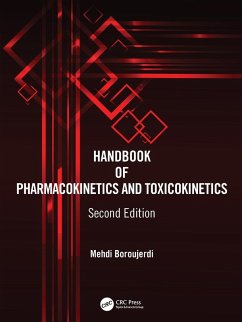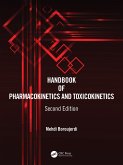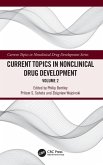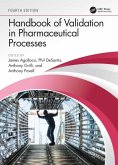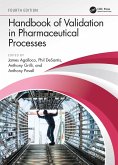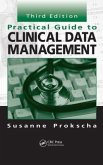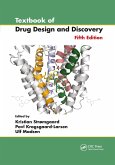Mehdi Boroujerdi ( College of Health Sciences - School of Pharmacy
Handbook of Pharmacokinetics and Toxicokinetics
Mehdi Boroujerdi ( College of Health Sciences - School of Pharmacy
Handbook of Pharmacokinetics and Toxicokinetics
- Broschiertes Buch
- Merkliste
- Auf die Merkliste
- Bewerten Bewerten
- Teilen
- Produkt teilen
- Produkterinnerung
- Produkterinnerung
The main contribution of the principles of pharmacokinetics and toxicokinetics is to summarize the large quantity of observations in simple mathematical relationships, which then facilitate extrapolation and projection beyond the observations.
Andere Kunden interessierten sich auch für
![Handbook of Pharmacokinetics and Toxicokinetics Handbook of Pharmacokinetics and Toxicokinetics]() Mehdi BoroujerdiHandbook of Pharmacokinetics and Toxicokinetics203,99 €
Mehdi BoroujerdiHandbook of Pharmacokinetics and Toxicokinetics203,99 €![Current Topics in Nonclinical Drug Development Current Topics in Nonclinical Drug Development]() Current Topics in Nonclinical Drug Development251,99 €
Current Topics in Nonclinical Drug Development251,99 €![Introduction to Toxicology Introduction to Toxicology]() John TimbrellIntroduction to Toxicology101,99 €
John TimbrellIntroduction to Toxicology101,99 €![Handbook of Validation in Pharmaceutical Processes, Fourth Edition Handbook of Validation in Pharmaceutical Processes, Fourth Edition]() Handbook of Validation in Pharmaceutical Processes, Fourth Edition53,99 €
Handbook of Validation in Pharmaceutical Processes, Fourth Edition53,99 €![Handbook of Validation in Pharmaceutical Processes, Fourth Edition Handbook of Validation in Pharmaceutical Processes, Fourth Edition]() Handbook of Validation in Pharmaceutical Processes, Fourth Edition305,99 €
Handbook of Validation in Pharmaceutical Processes, Fourth Edition305,99 €![Practical Guide to Clinical Data Management Practical Guide to Clinical Data Management]() Susanne ProkschaPractical Guide to Clinical Data Management202,99 €
Susanne ProkschaPractical Guide to Clinical Data Management202,99 €![Textbook of Drug Design and Discovery Textbook of Drug Design and Discovery]() Textbook of Drug Design and Discovery57,99 €
Textbook of Drug Design and Discovery57,99 €-
-
-
The main contribution of the principles of pharmacokinetics and toxicokinetics is to summarize the large quantity of observations in simple mathematical relationships, which then facilitate extrapolation and projection beyond the observations.
Produktdetails
- Produktdetails
- Verlag: Taylor & Francis Ltd
- 2 ed
- Seitenzahl: 782
- Erscheinungstermin: 19. Dezember 2024
- Englisch
- Abmessung: 280mm x 210mm x 42mm
- Gewicht: 1824g
- ISBN-13: 9781032197470
- ISBN-10: 1032197471
- Artikelnr.: 72109644
- Herstellerkennzeichnung
- Libri GmbH
- Europaallee 1
- 36244 Bad Hersfeld
- gpsr@libri.de
- Verlag: Taylor & Francis Ltd
- 2 ed
- Seitenzahl: 782
- Erscheinungstermin: 19. Dezember 2024
- Englisch
- Abmessung: 280mm x 210mm x 42mm
- Gewicht: 1824g
- ISBN-13: 9781032197470
- ISBN-10: 1032197471
- Artikelnr.: 72109644
- Herstellerkennzeichnung
- Libri GmbH
- Europaallee 1
- 36244 Bad Hersfeld
- gpsr@libri.de
Dr Mehdi Boroujerdi earned his PhD in pharmaceutics and pharmacokinetics from the University of North Carolina at Chapel Hill in 1978. He completed his post-doctoral training at the National Institutes of Health, National Institute of Environmental Health Sciences at Research Triangle Park. He served as professor of pharmaceutics/pharmacokinetics with tenure at Northeastern University, Boston, MA (1982-2002); professor of pharmaceutics and pharmacokinetics at the MCPHS University, School of Pharmacy, Boston, MA (2002-2005); professor of pharmaceutical sciences with tenure at the Albany College of Pharmacy and Health Sciences, Albany, New York (2005-2015); and professor of pharmaceutical sciences with tenure at the College of Health Sciences, University of Massachusetts, Lowell, MA (2015-2017). Dr Boroujerdi has also served as Dean of the School of Pharmacy at Bouvé College of Health Sciences at Northeastern University (1988-1999); as Dean of the School of Pharmacy-Boston at MCPHS University (2002-2005); as Dean of Pharmacy and Vice President for Academic Affairs, Provost, at the Albany College of Pharmacy and Health Sciences (2006-2012); and Founding Dean of the School of Pharmacy and Pharmaceutical Sciences at the College of Health Sciences, University of Massachusetts at Lowell (2015-2017). He also served as the Dean of Research and Graduate Studies at MCPHS (2003-2005), and Director of Graduate Programs in Biomedical Sciences at Northeastern University (1988-1999). Dr Boroujerdi has 112 peer-reviewed publications and is the sole author of two books Pharmacokinetics, Principles and Applications (McGraw Hill, 2002) and Pharmacokinetics and Toxicokinetics (CRC Publications, 2015). He has trained many graduate and undergraduate students through his research programs focused on pharmacokinetics and toxicodynamics of anticancer drugs, carcinogenesis, and efflux proteins. He also served as consultant to five pharmaceutical companies. As a professor he taught graduate courses in advanced pharmacokinetics and biopharmaceutics, drug metabolism, advanced pharmaceutics, and drug delivery systems. His teaching of undergraduate courses included drug discovery and development, biopharmaceutics and pharmacokinetics, physical pharmacy and pharmaceutics, and pharmacokinetics in disease states.
Chapter 1. Pharmacokinetics and Toxicokinetics. Chapter 2. PK-TK
Conisderations of Auricular (Optic) - Buccal/Sublingual and
Ocular/Ophthalmic Routes of Administration. Chapter 3. PK-TK Considerations
of Nasal, Pulmonary and Oral Routes of Administration. Chapter 4. PK-TK
Considerations of Intraarterial - Intramuscular Intraperitoneal -
Intravenous - and Subcutaneous Routes of Administration. Chapter 5. PK-TK
Considerations of Transdermal - Intradermal - and Intraepidermal Routes of
Administration. Chapter 6. PK-TK Considerations of Rectal - Vaginal -
Intraovarian Routes of Administration. Chapter 7. PK-TK Considerations of
Absorption Mechanisms and Rate Equations. Chapter 8. PK-TK Considerations
of Distribution Mechanisms and Rate Equations. Chapter 8. PK-TK
Considerations of Metabolism Biotransformation of Xenobiotics Mechanisms
and Rate Equations. Chapter 10. PK-TK Considerations of Renal Function and
Elimination of Xenobiotics Estimation of Parameters and Constants. Chapter
11. Elimination Rates & Clearances (Excretion + Metabolism). Chapter 12.
Approaches in PK-PD and TK-TD Mathematical Modeling. Chapter 13. Practical
Applications of PK/TK Models Instantaneous Exposure to Xenobiotics Single
Intravenous Bolus Injection. Chapter 14. Practical Applications of PK/TK
Models Continuous Zero-Order Exposure to Xenobiotics Intravenous Infusion.
Chapter 15. Practical Applications of PK/TK Models First-order Absorption
via Extravascular Routes Oral Administration. Chapter 16. Practical
Application of PK/TK Models Multiple Dosing Kinetics. Chapter 17.
Biopharmaceutics Provisions, Dynamics, and Classifications Mechanistic
Absorption Models. Chapter 18. Bioavailability, Bioequivalence and
Biosimilarity. Chapter 19. Quantitative Extrapolations Cross-Species
Extrapolation Low-Dose Extrapolation. Chapter 20. Practical Application of
PK/TK Models Population Pharmacokinetics/Toxicokinetics. Chapter 21.
Practical Application of PK/TK Models Preclinical PK/TK and Clinical
Trials. Chapter 22. Adjustment of Dosage Regimen Renal Impairment, Liver
Diseases, Pregnancy.
Conisderations of Auricular (Optic) - Buccal/Sublingual and
Ocular/Ophthalmic Routes of Administration. Chapter 3. PK-TK Considerations
of Nasal, Pulmonary and Oral Routes of Administration. Chapter 4. PK-TK
Considerations of Intraarterial - Intramuscular Intraperitoneal -
Intravenous - and Subcutaneous Routes of Administration. Chapter 5. PK-TK
Considerations of Transdermal - Intradermal - and Intraepidermal Routes of
Administration. Chapter 6. PK-TK Considerations of Rectal - Vaginal -
Intraovarian Routes of Administration. Chapter 7. PK-TK Considerations of
Absorption Mechanisms and Rate Equations. Chapter 8. PK-TK Considerations
of Distribution Mechanisms and Rate Equations. Chapter 8. PK-TK
Considerations of Metabolism Biotransformation of Xenobiotics Mechanisms
and Rate Equations. Chapter 10. PK-TK Considerations of Renal Function and
Elimination of Xenobiotics Estimation of Parameters and Constants. Chapter
11. Elimination Rates & Clearances (Excretion + Metabolism). Chapter 12.
Approaches in PK-PD and TK-TD Mathematical Modeling. Chapter 13. Practical
Applications of PK/TK Models Instantaneous Exposure to Xenobiotics Single
Intravenous Bolus Injection. Chapter 14. Practical Applications of PK/TK
Models Continuous Zero-Order Exposure to Xenobiotics Intravenous Infusion.
Chapter 15. Practical Applications of PK/TK Models First-order Absorption
via Extravascular Routes Oral Administration. Chapter 16. Practical
Application of PK/TK Models Multiple Dosing Kinetics. Chapter 17.
Biopharmaceutics Provisions, Dynamics, and Classifications Mechanistic
Absorption Models. Chapter 18. Bioavailability, Bioequivalence and
Biosimilarity. Chapter 19. Quantitative Extrapolations Cross-Species
Extrapolation Low-Dose Extrapolation. Chapter 20. Practical Application of
PK/TK Models Population Pharmacokinetics/Toxicokinetics. Chapter 21.
Practical Application of PK/TK Models Preclinical PK/TK and Clinical
Trials. Chapter 22. Adjustment of Dosage Regimen Renal Impairment, Liver
Diseases, Pregnancy.
Chapter 1. Pharmacokinetics and Toxicokinetics. Chapter 2. PK-TK
Conisderations of Auricular (Optic) - Buccal/Sublingual and
Ocular/Ophthalmic Routes of Administration. Chapter 3. PK-TK Considerations
of Nasal, Pulmonary and Oral Routes of Administration. Chapter 4. PK-TK
Considerations of Intraarterial - Intramuscular Intraperitoneal -
Intravenous - and Subcutaneous Routes of Administration. Chapter 5. PK-TK
Considerations of Transdermal - Intradermal - and Intraepidermal Routes of
Administration. Chapter 6. PK-TK Considerations of Rectal - Vaginal -
Intraovarian Routes of Administration. Chapter 7. PK-TK Considerations of
Absorption Mechanisms and Rate Equations. Chapter 8. PK-TK Considerations
of Distribution Mechanisms and Rate Equations. Chapter 8. PK-TK
Considerations of Metabolism Biotransformation of Xenobiotics Mechanisms
and Rate Equations. Chapter 10. PK-TK Considerations of Renal Function and
Elimination of Xenobiotics Estimation of Parameters and Constants. Chapter
11. Elimination Rates & Clearances (Excretion + Metabolism). Chapter 12.
Approaches in PK-PD and TK-TD Mathematical Modeling. Chapter 13. Practical
Applications of PK/TK Models Instantaneous Exposure to Xenobiotics Single
Intravenous Bolus Injection. Chapter 14. Practical Applications of PK/TK
Models Continuous Zero-Order Exposure to Xenobiotics Intravenous Infusion.
Chapter 15. Practical Applications of PK/TK Models First-order Absorption
via Extravascular Routes Oral Administration. Chapter 16. Practical
Application of PK/TK Models Multiple Dosing Kinetics. Chapter 17.
Biopharmaceutics Provisions, Dynamics, and Classifications Mechanistic
Absorption Models. Chapter 18. Bioavailability, Bioequivalence and
Biosimilarity. Chapter 19. Quantitative Extrapolations Cross-Species
Extrapolation Low-Dose Extrapolation. Chapter 20. Practical Application of
PK/TK Models Population Pharmacokinetics/Toxicokinetics. Chapter 21.
Practical Application of PK/TK Models Preclinical PK/TK and Clinical
Trials. Chapter 22. Adjustment of Dosage Regimen Renal Impairment, Liver
Diseases, Pregnancy.
Conisderations of Auricular (Optic) - Buccal/Sublingual and
Ocular/Ophthalmic Routes of Administration. Chapter 3. PK-TK Considerations
of Nasal, Pulmonary and Oral Routes of Administration. Chapter 4. PK-TK
Considerations of Intraarterial - Intramuscular Intraperitoneal -
Intravenous - and Subcutaneous Routes of Administration. Chapter 5. PK-TK
Considerations of Transdermal - Intradermal - and Intraepidermal Routes of
Administration. Chapter 6. PK-TK Considerations of Rectal - Vaginal -
Intraovarian Routes of Administration. Chapter 7. PK-TK Considerations of
Absorption Mechanisms and Rate Equations. Chapter 8. PK-TK Considerations
of Distribution Mechanisms and Rate Equations. Chapter 8. PK-TK
Considerations of Metabolism Biotransformation of Xenobiotics Mechanisms
and Rate Equations. Chapter 10. PK-TK Considerations of Renal Function and
Elimination of Xenobiotics Estimation of Parameters and Constants. Chapter
11. Elimination Rates & Clearances (Excretion + Metabolism). Chapter 12.
Approaches in PK-PD and TK-TD Mathematical Modeling. Chapter 13. Practical
Applications of PK/TK Models Instantaneous Exposure to Xenobiotics Single
Intravenous Bolus Injection. Chapter 14. Practical Applications of PK/TK
Models Continuous Zero-Order Exposure to Xenobiotics Intravenous Infusion.
Chapter 15. Practical Applications of PK/TK Models First-order Absorption
via Extravascular Routes Oral Administration. Chapter 16. Practical
Application of PK/TK Models Multiple Dosing Kinetics. Chapter 17.
Biopharmaceutics Provisions, Dynamics, and Classifications Mechanistic
Absorption Models. Chapter 18. Bioavailability, Bioequivalence and
Biosimilarity. Chapter 19. Quantitative Extrapolations Cross-Species
Extrapolation Low-Dose Extrapolation. Chapter 20. Practical Application of
PK/TK Models Population Pharmacokinetics/Toxicokinetics. Chapter 21.
Practical Application of PK/TK Models Preclinical PK/TK and Clinical
Trials. Chapter 22. Adjustment of Dosage Regimen Renal Impairment, Liver
Diseases, Pregnancy.

